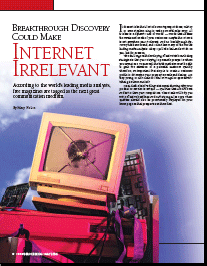Breakthrough Discovery Could Make Internet Irrelevant

 |
According to the world's leading media analysts, free magazines are tagged as the next great communication medium. |
The challenge with developing effective Web marketing strategies is that you're trying to persuade prospects whom you cannot see. To succeed, the Web marketer must be able to grab the attention of a potential customer quickly. Therefore, an important first step is to create a customer profile to determine your prospect's needs and desires. Are they young or old? Male or female? Frugal or spendthrift? What gets them excited?
Next, draft a brief "selling" statement showing why your product or service is unique - qualities that are different and better than your competitors. These tools will help you write effective headlines and craft strong sales copy. These qualities should also be prominently displayed on your home page so that prospects see them first.
Grab Their Attention
The most important element for a Web marketer is developing an enticing headline. Headlines should draw the prospect in, hold their attention and invite them to read more - a tricky proposition in a point-and-click world. If you've read this far, you no doubt were drawn in by our headline. Of course, it's false - and we don't recommend writing false headlines for your business - but it stood out and urged you to keep reading. Words like "Discover, "Announcing, "Breakthrough, "Facts, "New, "Now, "Yes" and "Sale" not only grab the attention of your customers but they promise them something. Two words, in particular, that have the most appeal for any customer are "You" and "Free. Studies show that when these words appear in headlines, customers will likely read beyond the headlines and into the body of the sales copy. Studies show further that only one out of five people read beyond the headline. If you are successful in getting readers to read on, chances are better that prospects will become customers - a great reason to spend time making headlines work.
Brief central statements or carefully crafted questions that stimulate your prospects and prod them into action are also effective. Some of the best headlines are those written in the form of a question. For instance, a headline like "Are You Sick and Tired of Working for Someone Else?" is effective because it appeals to your emotions. Emotions identify a specific need, want or desire. Your customer will want to read further. Headlines beginning with "How to" can also be effective in that they appeal to your customer's desire to learn, again prompting them to read more. Other examples of effective headlines are: "How to Boost Your Sales as High as 500% by Using this One Simple Approach" and "Double Your Revenue this Year with Our Cross-Zoning Solution." Additionally, headlines stated as testimonials such as "Writing Powerful Sales Copy for the Website is Pure Mastermind - Our Sales Have Jumped by 60%" are valuable because they establish credibility.
Compelling headlines no doubt draw attention to your site, but headline placement is equally important. Proper headline placement can turn a browser into a potential customer. Headlines positioned in banner ads and pop-up windows, for example, will at the very least inspire your customers to point and click. This point-and-click is an implied message that more than likely will trigger a call to action by your customer - generally the step right before the ultimate sale. Headline writing is an art in and of itself. It takes time and practice in using different combinations of words, questions and statements to achieve marketing success. It does not happen overnight, but it's always worth the effort.
Pull 'em on Deck
The "deck" is the brief statement right below the headline. It's should be no more than a sentence or two, and should lay out what the reader can expect to find in the article, without giving away the entire content.
In our example, we introduced a reason behind our headline and hinted at the content of the article with "free magazines are tagged .... We also established credibility by citing "leading media analysts. Both of these strategies will push the reader to keep reading with confidence.
The deck is a good way for Web marketers to get readers one step closer to reading your content, where the sale is made. It is vital that you deliver on your "promise" of the headline and deck. If not, you will lose credibility and your prospects will look elsewhere. It's also important to keep it brief, as many people have short attention spans when using the Web.
Sell With Content
With a strong headline and deck in place, Web marketers can shift to developing the body of their copy, or content. Content is king, as previously written by Chris Boggs in the last issue ("The Nitty-Gritty of Link Requests, February 2006). It is a crucial marketing tool that tells your customers everything they need to know about your particular service or product. Web customers are hungry for information but do not want to spend time perusing website after website.
- Be concise. Don't use unnecessary words that make sentences and paragraphs long. Stay away from the extra words that tell more about your business than about your customers. Customers are far more interested in reading about themselves than about your company. This is sage advice from many sales writing tutorials and resource guides posted on the Web. Good Web writers aspire toward simple, brief, vigorous and lucid content.
- Use the inverted pyramid style of writing. The most pertinent information is written first, followed by the least. Such style allows you to clearly communicate the direction of your content.
- Use subheads. To break up the copy from appearing monotonous, use brief descriptions such as "Sell With Content, above. Subheads break up the content and keep readers from tiring. Bullets and numbered lists, boldface type, quotations and color all do well to emphasize points in your content.
- Write informally. This may differentiate you from your competitors. It does not have to be elaborate or especially creative. Just in a style that grabs the attention of your particular prospects. Keep your sentences simple. Do not write to impress, write to communicate. You want to pre-sell your product or service. Your writing will almost seem as if you are talking to a child.
Don't Forget to Proof and Test
Nothing will kill a sale and drive away customers faster than sloppiness. Errors found in your Web copy can give prospects the idea that you are unprofessional. Such impressions will also filter over to your current customers, who will start looking elsewhere for their needs. Proofread your copy and read it aloud to yourself several times. And try reading it backwards. Obviously, by doing this, your copy will not read sensibly. But you are not reading for the copy to make sense - you are looking for errors. A spell check is always a good idea, but do not solely rely on it. Spell checks do not always pick up misspelled words, particularly in a specialty environment like the Web. A hard copy can make it easier to find grammatical or spelling errors as well.
Lastly, test your headlines, decks, copy and links several times over. Ask friends, family and co-workers to act as potential customers and look for any problems or inconsistencies. Fresh sets of eyes will usually find minor mistakes that eluded the site builder. -

Subscribe to Our Newsletter!
Latest in Marketing








